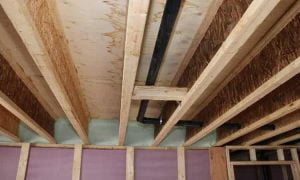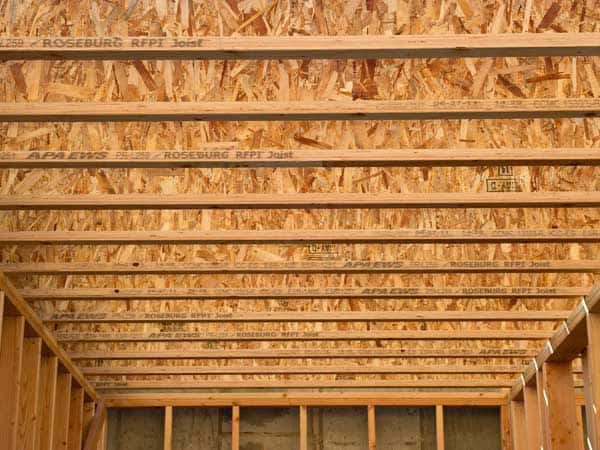Table of Contents
A Floor Joist may be defined as a timber beam that is perpendicular to the beam and parallel to the walls that is used for the purposes of providing a supportive framework for flooring.
It has a very essential role in the sub-floor structure because they convey the dead load of the furniture, flooring load, vibration of people walking and impact load, etc.
For the use of floor joists high-quality timber helps to provide durability, evenness of floor, and strength. This joist must be nearly placed and fixed in nature so that it easily carries all loads such as live load, dead load, impact load, and sagging of flooring, preventing bending, etc.
Floor Joist load-bearing depends upon the various factors which are as follows:
a. Grade of the timber or lumber.
b. Species of Wood.
c. Length of the joist span.
d. The load was placed on the floor.
e. Width of Timber Boards.
f. The thickness of Timber Boards.
2. Floor Joist Spacing
The floor joist placement is done between 12″ to 24″ Inches apart from the center, but it depends on the size of the floor joist timber size, building codes, and requirements of the design.
The following table shows the standard floor joist spacing with different sizes.
| Size | 12″ | 16″ | 24″ |
| 2 x 6 | 10 – 10 | 9 – 10 | 8 – 7 |
| 2 x 8 | 13 – 1 | 12 – 4 | 11 – 3 |
| 2 x 10 | 15 – 3 | 14 – 4 | 13 – 6 |
| 2 x 12 | 17 – 2 | 16 – 2 | 15 – 3 |
3. Calculation of Joist Size
For example, if you had a floor in a room that span is 20 feet, you would divide the room span and get 10 feet. That means you need a depth of joist that will be 10 inches.
The Standard Size of floor joists is 2×8, 2×10, and 2×12 and you can choose your suitable floor joists as authorized by the municipalities code.
4. Types of Floor Joists
Here most commonly used types of floor joists are given below,
a. I Shaped Floor Joist
b. Solid Lumber
c. Open Web Floor Joist
a. I Shaped Floor Joist
It is an engineering-type wood joist, known as a TJI Joist because they look like the capital letter I.
The different parts of the joist are prepared of various materials like Top and bottom parts of the joist are prepared with a covered with veneer or wood and the center part is prepared with an oriented strand board (OSB) or plywood.
It has a long span and is environment friendly in nature and carries higher loads than that solid timber. Another part of joists cannot withstand fire or water.
Advantages of I-Joists
a. This is having a longer span than solid wood joists.
b. These joists are easy to place.
Disadvantages of I-Joists
a. Less fire resistance.
b. It is very costly.

b. Solid Lumber Joists
Solid Lumber Joists are prepared of old-growth trees and solid timber.
The cost of solid lumber joists depends on a different factor which is as follows:
a. Size of Boards.
b. Grade of Wood.
c. Quality of Wood.
d. Life Span of Wood.
Advantages of Solid lumber joists
a. It last longer during a Fire.
b. It is less expensive compared to engineer-type wood.
Disadvantages of Solid lumber Joists
a. It is not environmentally friendly.
b. It is a design for Shorter Span.

c. Open Web Floor Truss
This type of joist provides a variety of various longer spans, variety of depth, and load-bearing capacity then you can try adopting an open web floor type. Wood Trusses are a containing a low moisture capacity and compress less.
Advantages of Open Web Floor Truss
a. These joists are suitable for a longer span.
b. These joists are accommodating the passing plumbing, electrical, and water supply line without cutting.
Disadvantages of Open Web Floor Truss
a. This is costly as compared to I-Joists.
b. These joists are difficult to Trimmed.

5. Advantages of Floor Joist
The advantages of floor joists are as follows:
✔ They are vertical members and work as a beam that shifts a load to the ground.
✔ They hold the structure.
✔ They are bearing the live load, dead load, and impact load.
✔ They are enough to convey the weight of whole new floors.
✔ Insertion process of the floor joist is easy and cheap.
6. Disadvantages of Floor Joist
The disadvantages of floor joists are as follows:
✔ They are not suitable for large areas.
✔ They are not placed without the support of walls, columns, and Beam.
✔ They have more weight as compared to other trusses.
✔ They have a restriction on design and model.
| Read Also: 38 Types of Wood |

